Yanzhen Liu
Benchmark of Segmentation Techniques for Pelvic Fracture in CT and X-ray: Summary of the PENGWIN 2024 Challenge
Apr 03, 2025Abstract:The segmentation of pelvic fracture fragments in CT and X-ray images is crucial for trauma diagnosis, surgical planning, and intraoperative guidance. However, accurately and efficiently delineating the bone fragments remains a significant challenge due to complex anatomy and imaging limitations. The PENGWIN challenge, organized as a MICCAI 2024 satellite event, aimed to advance automated fracture segmentation by benchmarking state-of-the-art algorithms on these complex tasks. A diverse dataset of 150 CT scans was collected from multiple clinical centers, and a large set of simulated X-ray images was generated using the DeepDRR method. Final submissions from 16 teams worldwide were evaluated under a rigorous multi-metric testing scheme. The top-performing CT algorithm achieved an average fragment-wise intersection over union (IoU) of 0.930, demonstrating satisfactory accuracy. However, in the X-ray task, the best algorithm attained an IoU of 0.774, highlighting the greater challenges posed by overlapping anatomical structures. Beyond the quantitative evaluation, the challenge revealed methodological diversity in algorithm design. Variations in instance representation, such as primary-secondary classification versus boundary-core separation, led to differing segmentation strategies. Despite promising results, the challenge also exposed inherent uncertainties in fragment definition, particularly in cases of incomplete fractures. These findings suggest that interactive segmentation approaches, integrating human decision-making with task-relevant information, may be essential for improving model reliability and clinical applicability.
SpikACom: A Neuromorphic Computing Framework for Green Communications
Feb 24, 2025Abstract:The ever-growing power consumption of wireless communication systems necessitates more energy-efficient algorithms. This paper introduces SpikACom ({Spik}ing {A}daptive {Com}munication), a neuromorphic computing-based framework for power-intensive wireless communication tasks. SpikACom leverages brain-inspired spiking neural networks (SNNs) for efficient signal processing. It is designed for dynamic wireless environments, helping to mitigate catastrophic forgetting and facilitate adaptation to new circumstances. Moreover, SpikACom is customizable, allowing flexibly integration of domain knowledge to enhance it interpretability and efficacy. We validate its performance on fundamental wireless communication tasks, including task-oriented semantic communication, multiple-input multiple-output (MIMO) beamforming, and orthogonal frequency-division multiplexing (OFDM) channel estimation. The simulation results show that SpikACom significantly reduces power consumption while matching or exceeding the performance of conventional algorithms. This study highlights the potential of SNNs for enabling greener and smarter wireless communication systems.
Latency Minimization for mmWave D2D Mobile Edge Computing Systems: Joint Task Allocation and Hybrid Beamforming Design
Jul 17, 2022
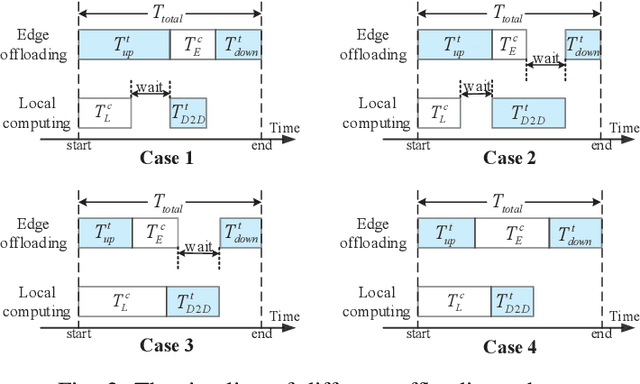
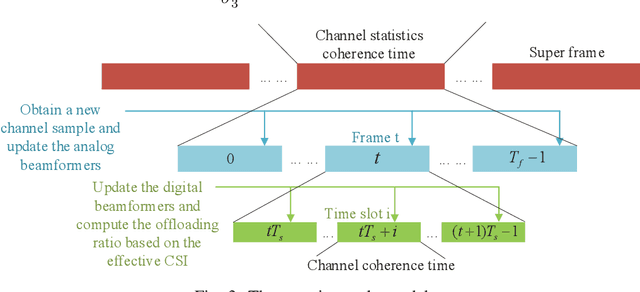
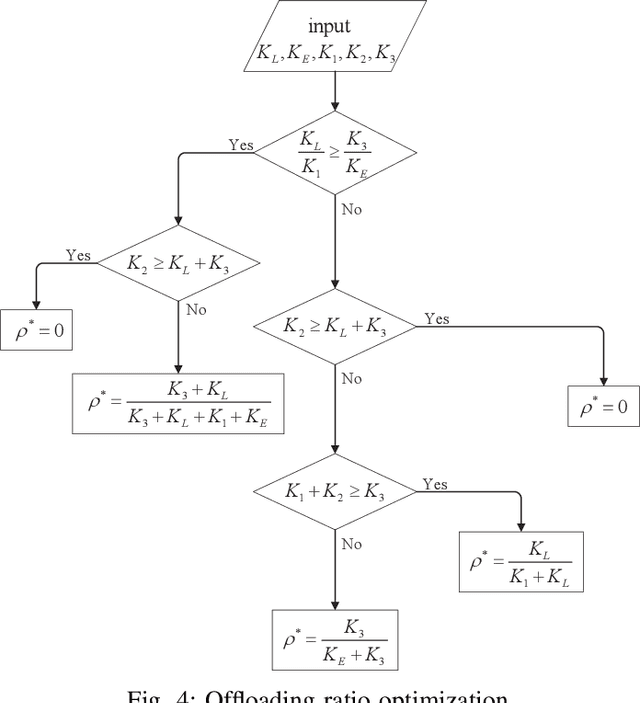
Abstract:Mobile edge computing (MEC) and millimeter wave (mmWave) communications are capable of significantly reducing the network's delay and enhancing its capacity. In this paper we investigate a mmWave and device-to-device (D2D) assisted MEC system, in which user A carries out some computational tasks and shares the results with user B with the aid of a base station (BS). We propose a novel two-timescale joint hybrid beamforming and task allocation algorithm to reduce the system latency whilst cut down the required signaling overhead. Specifically, the high-dimensional analog beamforming matrices are updated in a frame-based manner based on the channel state information (CSI) samples, where each frame consists of a number of time slots, while the low-dimensional digital beamforming matrices and the offloading ratio are optimized more frequently relied on the low-dimensional effective channel matrices in each time slot. A stochastic successive convex approximation (SSCA) based algorithm is developed to design the long-term analog beamforming matrices. As for the short-term variables, the digital beamforming matrices are optimized relying on the innovative penalty-concave convex procedure (penalty-CCCP) for handling the mmWave non-linear transmit power constraint, and the offloading ratio can be obtained via the derived closed-form solution. Simulation results verify the effectiveness of the proposed algorithm by comparing the benchmarks.
Deep-Unfolding Beamforming for Intelligent Reflecting Surface assisted Full-Duplex Systems
Dec 04, 2021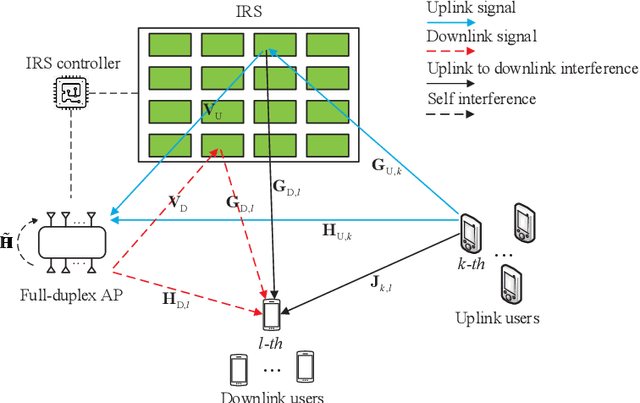
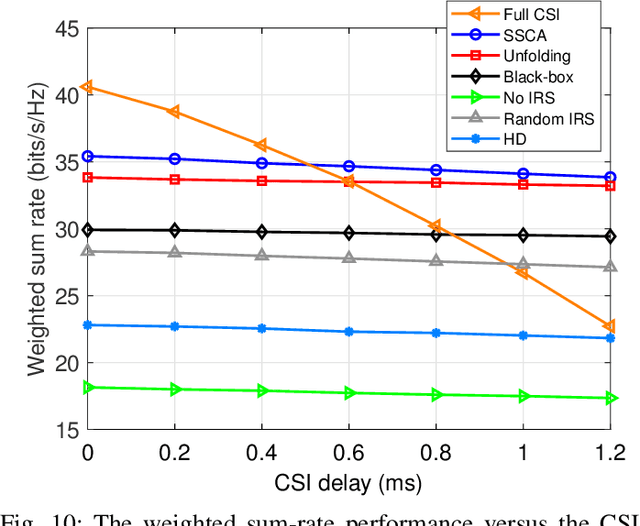
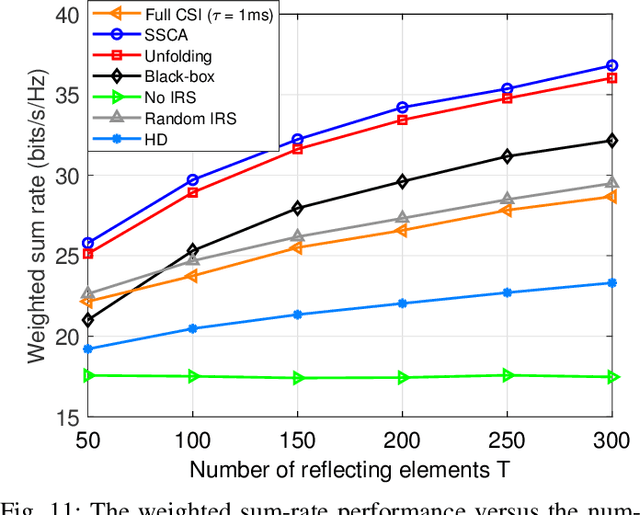
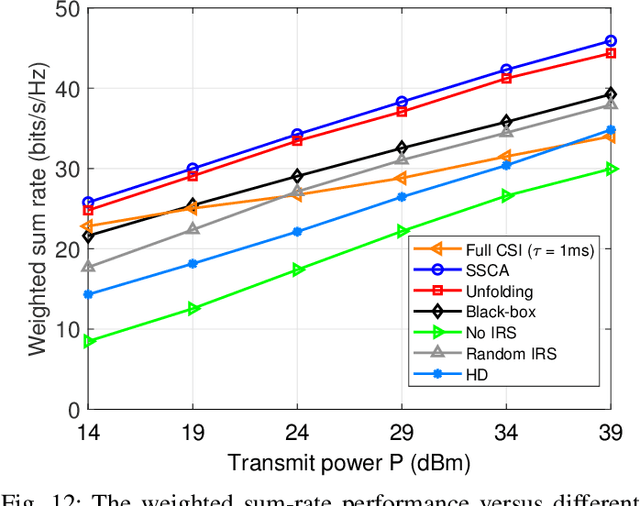
Abstract:In this paper, we investigate an intelligent reflecting surface (IRS) assisted multi-user multiple-input multiple-output (MIMO) full-duplex (FD) system. We jointly optimize the active beamforming matrices at the access point (AP) and uplink users, and the passive beamforming matrix at the IRS to maximize the weighted sum-rate of the system. Since it is practically difficult to acquire the channel state information (CSI) for IRS-related links due to its passive operation and large number of elements, we conceive a mixed-timescale beamforming scheme. Specifically, the high-dimensional passive beamforming matrix at the IRS is updated based on the channel statistics while the active beamforming matrices are optimized relied on the low-dimensional real-time effective CSI at each time slot. We propose an efficient stochastic successive convex approximation (SSCA)-based algorithm for jointly designing the active and passive beamforming matrices. Moreover, due to the high computational complexity caused by the matrix inversion computation in the SSCA-based optimization algorithm, we further develop a deep-unfolding neural network (NN) to address this issue. The proposed deep-unfolding NN maintains the structure of the SSCA-based algorithm but introduces a novel non-linear activation function and some learnable parameters induced by the first-order Taylor expansion to approximate the matrix inversion. In addition, we develop a black-box NN as a benchmark. Simulation results show that the proposed mixed-timescale algorithm outperforms the existing single-timescale algorithm and the proposed deep-unfolding NN approaches the performance of the SSCA-based algorithm with much reduced computational complexity when deployed online.
Latency Minimization in Intelligent Reflecting Surface Assisted D2D Offloading Systems
Jan 12, 2021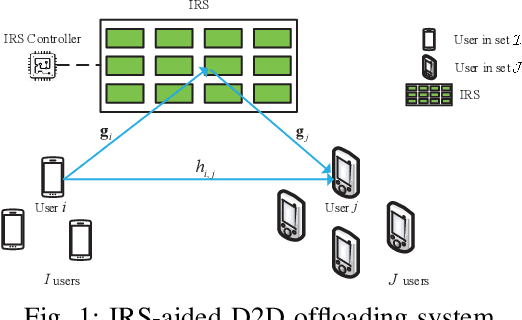

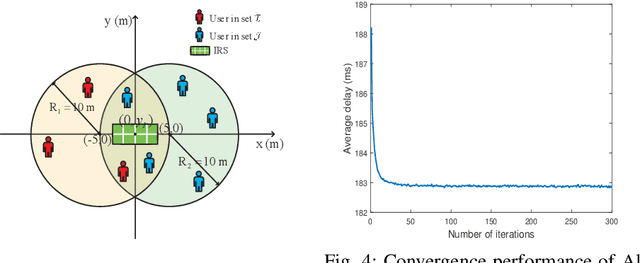

Abstract:In this letter, we investigate an intelligent reflecting surface (IRS) aided device-to-device (D2D) offloading system, where an IRS is employed to assist in computation offloading from a group of users with intensive tasks to another group of idle users. We propose a new two-timescale joint passive beamforming and resource allocation algorithm based on stochastic successive convex approximation to minimize the system latency while cutting down the heavy overhead in exchange of channel state information (CSI). Specifically, the high-dimensional passive beamforming vector at the IRS is updated in a frame-based manner based on the channel statistics, where each frame consists of a number of time slots, while the offloading ratio and user matching strategy are optimized relied on the low-dimensional real-time effective channel coefficients in each time slot. The convergence property and the computational complexity of the proposed algorithm are also examined. Simulation results show that our proposed algorithm significantly outperforms the conventional benchmarks.
Joint Deep Reinforcement Learning and Unfolding: Beam Selection and Precoding for mmWave Multiuser MIMO with Lens Arrays
Jan 05, 2021

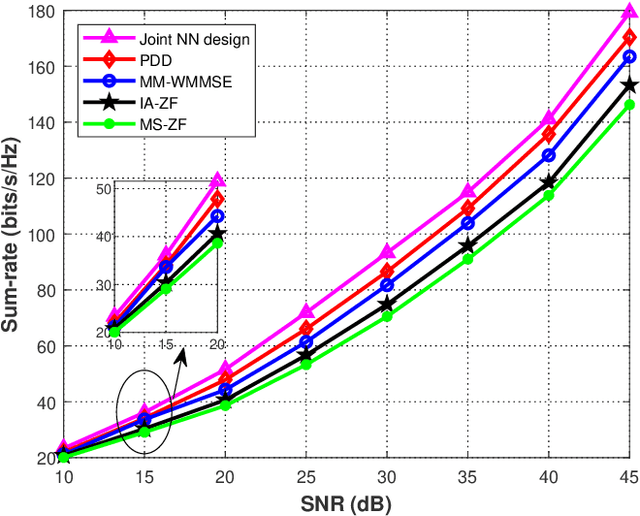

Abstract:The millimeter wave (mmWave) multiuser multiple-input multiple-output (MU-MIMO) systems with discrete lens arrays (DLA) have received great attention due to their simple hardware implementation and excellent performance. In this work, we investigate the joint design of beam selection and digital precoding matrices for mmWave MU-MIMO systems with DLA to maximize the sum-rate subject to the transmit power constraint and the constraints of the selection matrix structure. The investigated non-convex problem with discrete variables and coupled constraints is challenging to solve and an efficient framework of joint neural network (NN) design is proposed to tackle it. Specifically, the proposed framework consists of a deep reinforcement learning (DRL)-based NN and a deep-unfolding NN, which are employed to optimize the beam selection and digital precoding matrices, respectively. As for the DRL-based NN, we formulate the beam selection problem as a Markov decision process and a double deep Q-network algorithm is developed to solve it. The base station is considered to be an agent, where the state, action, and reward function are carefully designed. Regarding the design of the digital precoding matrix, we develop an iterative weighted minimum mean-square error algorithm induced deep-unfolding NN, which unfolds this algorithm into a layerwise structure with introduced trainable parameters. Simulation results verify that this jointly trained NN remarkably outperforms the existing iterative algorithms with reduced complexity and stronger robustness.
 Add to Chrome
Add to Chrome Add to Firefox
Add to Firefox Add to Edge
Add to Edge